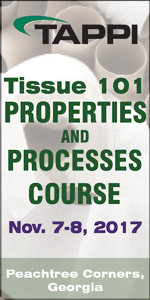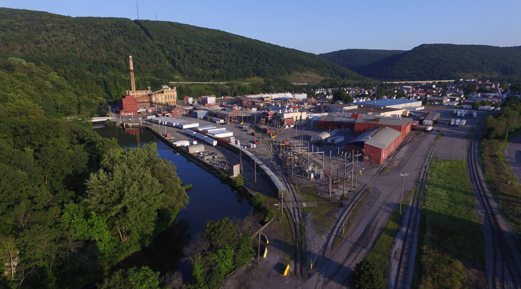 |
||||||||
| September 6, 2017 | ||||||||
| High power generation from recovery boilers - What are the limits? |  |
|||||||
|
· Subscribe to Ahead of the Curve · Newsletters · Ahead of the Curve archived issues · Contact the Editor
|
Ready to Compete for Another Century BY GRAEME RODDEN Note: The full version of this article will appear in the forthcoming September/October issue of Paper360°. This excerpt is offered here as a “sneak peek” for AoTC readers. Greek mythology describes the Phoenix as the bird that is cyclically regenerated or reborn; typically the Phoenix rises from the ashes. In this story, the phoenix is an eagle—American Eagle Paper Mills, Tyrone, PA. It began Project Phoenix in 2013 to “reinvent the mill’s critical infrastructures by primarily focusing on efficiency.” Energy—water, steam, electricity—was the main target. The mill was built in 1880 and is one of the oldest operating paper mills in the US. Management realized improvement had to be made to ensure the mill’s future; the project also provided immense environmental benefits. The mill now produces 85,000 tons/yr of uncoated printing and writing grades using a 100 percent recycled furnish. There are two 1940s-vintage paper machines (Pusey & Jones), which have gone through numerous upgrades over the years. “There’s not much original stuff left,” notes American Eagle CEO Mike Grimm. Its main market segment is recycled copy paper. American Eagle can take advantage of many government (local, state, federal) regulations that mandate the use of recycled content in the paper that “tax-supported offices” buy. “We’ve grown rapidly in this segment recently,” Grimm says. The mill also produces general offset, envelope, and some colored paper grades, as well as private label paper. Project Phoenix addressed multiple issues facing the mill. Grimm lists the three biggest risks: The mill’s frequency converter was the only one of its type in the world. As Grimm points out, “If it had failed, it would have been catastrophic for continuity.”
There were also issues with the insurer, which wanted changes to the electrical system. The process began in 2013 with a lot of evaluation. The mill was spending about US$12 million annually on steam, power generation and purchased power. As the team went through the mill, it started to discover it had opened a “can of worms” because of the equipment inefficiency (too big, too old). Basically, the three main pieces—boiler, steam turbine generator, old static frequency converter—were due to fail and if any one of the three did, the mill would need to be shut. “We also realized how much steam we need to run the paper machines and this put us in the direction of a package boiler,” Grimm adds. The project team studied multiple alternatives, and made technical decisions by early 2015. To get through the capitalization of the project, ownership had to be restructured. In June/July 2015, orders for the larger equipment were placed. Construction started in February, 2016. Luckily, an existing building was able to house the new gas-fired package boiler. The new boiler and frequency converter were turned on in mid-July 2016. Total cost was US$8 million. It should be noted that the project was all debt or equity financed; there were no grants received. Right-Sizing Power American Eagle worked with the local utility to shut the mill’s power generating capacity and instead buy power from the grid. Before the US adopted 60Hz as a national standard frequency for the electrical grid, some power utilities operated on a frequency of their own choice (in Pennsylvania, 25Hz was quite common.) This means companies established before this nationwide standard had electrical equipment that operated on a different frequency and were incompatible with the power grid. This was the case for American Eagle—it was built in 1880, long before the national standard was set. With its equipment operating on a 25 Hz frequency, the facility was incompatible with the 60 Hz distribution grid. To solve this problem, the paper mill used a steam turbine that powered the facility at a 25 Hz frequency and allowed the equipment to run. While using the generator was more economically viable than upgrading all of the motors and machinery, maintaining and operating the steam generator to produce electrical power was becoming cost prohibitive. To help reduce operating costs and maintenance, ABB was asked to supply American Eagle with a static frequency converter (SFC) to source power from the 60 Hz grid and convert it to 25 Hz. This would enable the generator to more efficiently power the facility and equipment.
The mill is located in a strong power-generating region: hydro, natural gas (fracking), and coal are all available, so American Eagle was able to negotiate an “attractive” long-term (five+ years) power supply agreement. It now purchases about 8 MW. “For us, buying power and installing the package boiler for steam generation made a lot of sense,” Grimm says. Payback is estimated at less than three years. Environmentally, greenhouse gas emissions have dropped by 68.7 percent, to 103,815 tons/yr (combined savings for overall emissions footprint: electrical and steam). Purchased energy efficiency (MMBtu improvement per ton of paper) has improved 33.7 percent to 14.6 MMBtu. The old frequency converter was installed in the 1990s and it could convert 25 HZ to 60 Hz. However, the mill was still limited. It wanted to drop all 25-Hz power but delayed the decision. Now, if it wants to shed more 25-Hz power, it has the ability. Saving Water The total reduction in daily water consumption has been 1.5 million gallons, a savings of 91 percent. Process water effluent per ton of paper has been reduced by about 2,000 gallons, an 18.1 percent saving. The mill installed 5,000 ft of new piping, improving the efficiency of the steam distribution and collection of condensate to reduce waste. A custom water treatment system, scaled to match the new boiler, treats condensate more efficiently and helps to further reduce water waste. The mill makes up 100 gal/min of fresh water. The old treatment system was close to the old boiler. From an efficiency standpoint, it made more sense for the system to go into the new boiler building. Although space was tight, the mill made it work. Fresh water first passes through a clarifier that American Eagle bought used. There are three new multi-media filters, three new ion exchange softeners, and a new deaerator. The new condensate return system was tied into the existing repurposed condensate polisher.
A year after completion, Project Phoenix has taken flight. The mill faced only “limited” issues after startup. The frequency convertor has operated “solidly,” as has the new boiler. “We are in a small niche,” Grimm explains. “We are the low-cost recycled manufacturer in the US. We manufacture more 100 percent recycled paper than anyone else.” This is the niche in which American Eagle will continue to focus its product development: virgin products that today have no recycled equivalent. “The flexible recycled mills will be successful in the future,” Grimm concludes. Graeme Rodden is Senior Editor, North and South America, Paper360°. He can be reached at grodden@tappi.org.
For a modest investment of $174, receive more than US$ 1000 in benefits in return. |
|||||||
 |
||||||||

 American Eagle is one of the oldest operating paper mills in the US; the original buildings date back to 1880.
American Eagle is one of the oldest operating paper mills in the US; the original buildings date back to 1880.